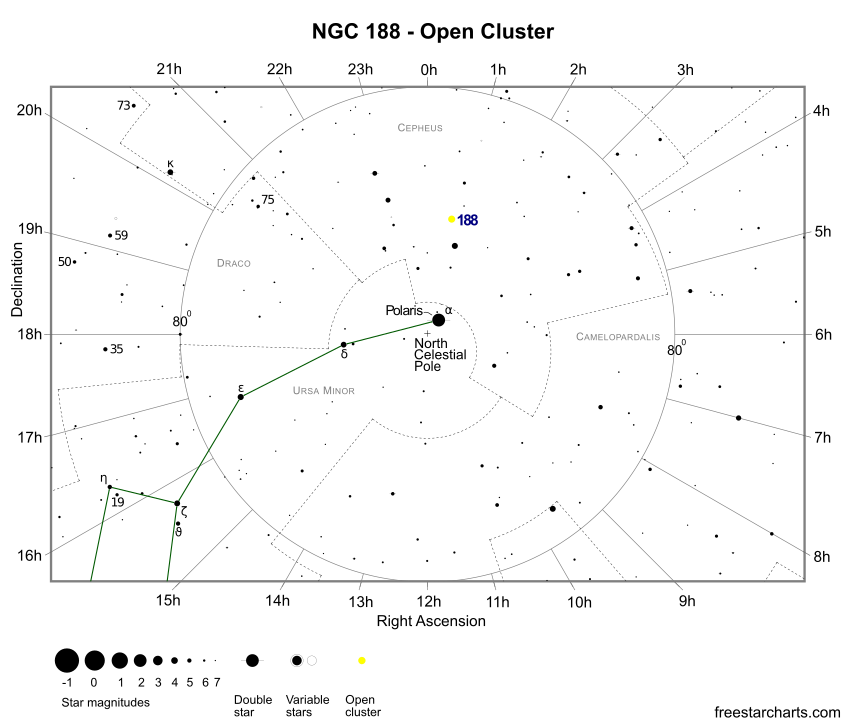NGC 188 is an open cluster located in the far northern constellation of Cepheus. John Herschel, the son of William Hershel, discovered it on November 3, 1831. He originally recorded it as h34 in his 1833 catalogue and then as GC92 in his General Catalogue of 1864. The cluster eventually became NGC 188 in John L.E. Dreyer's New General Catalogue of 1888.
NGC 188 is positioned 4.75 degrees from the North Celestial Pole and is the northernmost open cluster in the sky. It's effectively circumpolar from all Northern Hemisphere locations. However, it can never be seen from latitudes south of 5 degrees south.


Finder Chart for NGC 188 - pdf format (credit:- freestarcharts)
With an apparent magnitude of +8.1, NGC 188 is visible with binoculars. On dark nights, it can be spotted as a faint patch of light through 7x50 or 10x50 models. The cluster has a low surface brightness and is therefore best seen with medium size scopes or larger. A 150mm (6-inch) reflector reveals a soft glow of light that can initially appear unresolved, but on further inspection a sprinkling of faint stars can be made out. The brightest individual members shine at 12th magnitude and there are at least 130 stars above 17th magnitude. Through 250mm (10-inch) scopes, NGC 188 is a wonderful sight with dozens of stars visible across the entire cluster face. In total, it spans 15 arc minutes of apparent sky.
Studies indicate that NGC 188 is probably the oldest known open cluster and at least five billion years old. For comparison, the Pleiades (M45) cluster in Taurus is a youthful 115 million years of age. A factor contributing to the longevity of NGC 188 is it lies well away from the plane of the galaxy, and therefore has avoided disturbances that regularly occur in higher density star regions.
Since most open star clusters are young, they typically contain luminous hot blue giant stars. However, older clusters like NGC 188 tend to contain yellow and red stars and are almost devoid of blue stars.
NGC 188 has an actual diameter of 33 light-years and is estimated to be about 5,000 light-years away. It's the first object in the Caldwell catalogue.
NGC 188 Data Table
| NGC | 188 |
|---|---|
| Caldwell | 1 |
| Object Type | Open Cluster |
| Constellation | Cepheus |
| Distance (light-years) | 5,000 |
| Apparent Mag. | +8.1 |
| RA (J2000) | 00h 47m 30s |
| DEC (J2000) | +85h 14m 29s |
| Apparent Size (arc mins) | 15 x 15 |
| Radius (light-years) | 11 |
| Age (years) | 5 Billion |
| Number of Stars | >130 |
| Other Name | Collinder 6 |
| Notable Feature | Most northerly open cluster in the sky |